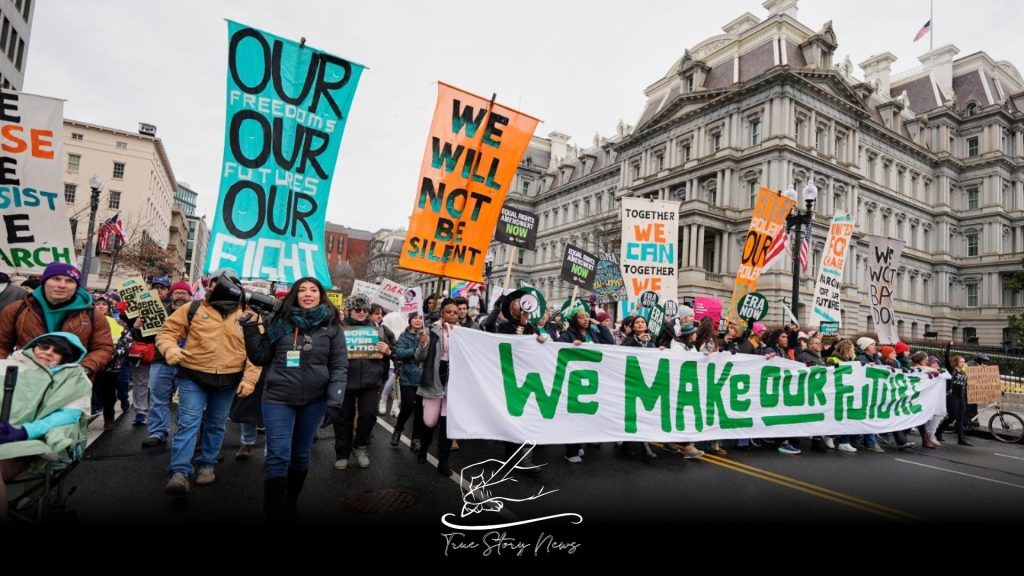On Saturday, a significant number of predominantly female protesters gathered in the streets of Washington DC to voice their opposition to President-elect Donald Trump, just two days before his inauguration.
The People’s March, formerly recognised as the Women’s March, has been held annually since 2017.
A coalition of organisations has initiated the movement, declaring its objective to challenge “Trumpism,” as outlined on its official website. In New York City and Seattle, smaller protests against Trump occurred, reflecting dissent in various parts of the country.
The rallies align with Trump’s arrival in the nation’s capital as he prepares for a series of weekend events leading to his swearing-in ceremony on Monday.
Saturday’s People’s March in Washington, DC, attracted fewer participants than previous events.
Organisers anticipated a turnout of 50,000 individuals. Approximately 5,000 individuals attended the event.
A crowd of protesters convened at three parks before marching towards the Lincoln Memorial, where a rally was scheduled to take place.
On their website, the march organisers describe themselves as embodying “intersecting identities” and pursuing “varied issue-based interests,” addressing a range of causes, including climate change, immigration, and women’s rights.
Women who assembled in Washington for the People’s March shared a range of motivations behind their participation with the BBC.
Brooke, a protester, expressed her desire to demonstrate support for access to abortion services.
“She expressed her dissatisfaction with the recent voting outcomes in the country.” “It is disheartening to witness our nation gravitating towards a president who has previously let us down, coupled with the absence of a female candidate in the nomination process.”
Kayla expressed that a blend of emotions motivated her to take to the streets of the nation’s capital.
“I am feeling a mix of anger, sadness, and overwhelming emotions,” she expressed.
The initial version of the People’s March was organised following Donald Trump’s 2016 victory over Democratic presidential candidate Hillary Clinton.
In the wake of Trump’s inaugural ceremony, women organised a protest that drew the participation of hundreds of thousands of individuals the following day.
The movement extended its reach beyond the nation’s capital, as millions of women throughout the United States took to the streets, brandishing signs that criticised the Republican president.
Many donned pink knit hats, a symbolic nod to a controversial leaked tape in which Trump boasted about inappropriate behaviour towards women.
The Women’s March played a significant role in the ongoing opposition to Trump’s policies in the subsequent years.
However, none of the following marches have matched that level of participation.
On Saturday, Trump made his way to Washington, D.C., to kick off his inaugural celebrations. He started with a private gathering that included a fireworks display at his golf club in the Virginia suburbs.
The march’s organisers intended to challenge Trump by leveraging historical successes and proven tactics against authoritarian leaders.
A gathering of Trump supporters convened at the Washington Monument on Saturday. A leader from the People’s March, equipped with a loudhailer, approached the group of men wearing red Make America Great Again hats, chanting: “No Trump, no KKK.”
Timothy Wallis, one of the individuals involved, informed the Associated Press that his friends had recently purchased Trump hats from a street vendor.
Mr. Wallis, 58, from Pocatello, Idaho, expressed that the protesters of the People’s March possessed “every right” to demonstrate, although he conveyed his confusion regarding the hostility displayed.
“The current state of our nation is disheartening,” he remarked.
A protester interviewed by the BBC travelled to Washington expressly for the march.
Susie travelled from the San Francisco area to join her sister, Anne, for a demonstration nearby. Following Trump’s first inauguration, both individuals participated in the Women’s March, returning adorned in their distinctive “pussy hats.”
Susie reflected on the throngs of people in 2017 and hoped they would continue to protest against Trump’s policies.
“This time, the stakes are higher,” she remarked. Trump appears to have gained confidence, and the billionaire class and the tech elite appear to be yielding to his influence.
Anne acknowledged that the protesters appear disconnected from most of the American populace. In the November election, Trump secured victories in all seven swing states and the popular vote.
However, she emphasised, “We remain present and will continue to resist.”












